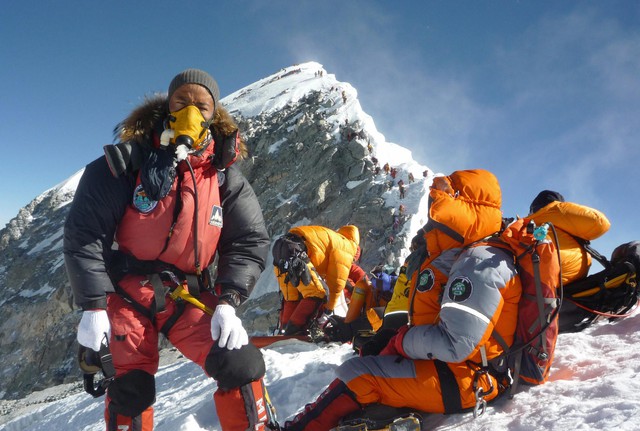The Sherpas of the Himalayas have evolved to become super mountain climbers
Since at least 6,000 years ago, the Sherpas have inhabited the highlands of the Himalayas, at an altitude of nearly 4,500 meters above sea level. Today, they are renowned as one of the best groups of climbers on the planet, and hold many climbing records. The Sherpas are also the people who fasten their seat belts on the climbing routes, and guide Westerners who want to climb Mount Everest.
But that is the story for now. Before the 1920s, the Sherpas made their living by farming in the high mountains, grazing cattle and spinning wool. The Sherpas traversed the peaks of the Himalayas but did not climb them, as they believed them to be the home of the gods.
When the British began planning expeditions to the Himalayas, they hired the Sherpas as porters. Since then, climbing has become an important part of Sherpa culture. Due to their willingness to guide Western mountaineers, and their ability to climb the highest peaks, the help of the Sherpas has greatly contributed to Himalayan exploration efforts.

Many Sherpas are employed as porters for climbers to Mount Everest. Despite accepting mountaineering as a livelihood, the Sherpas do not attempt to scale up the mountains they can climb, believing it to be the “House of the Gods” that they hold dear.
The first achievement was recorded in 1953 when a climber from New Zealand, Edmund Hillary, and one of the most famous Sherpas, Tenzing Norgay, became the first people to climb 29,028 feet ( 8,848 meters) of Mount Everest on May 29 of the same year.
After Hillary and Norgay’s successful attempt, foreign climbers flocked to the homeland of the Sherpas, with the aim of repeating the feat of climbing the world’s tallest mountain. As interest in climbing grew in the following years, so did the number of Sherpa guides hired.

Tenzing Norgay (right) and Edmund Hillary (left) after completing their first climb to Mount Everest on May 29, 1953.
Although the climbing industry has made them one of the wealthiest peoples in Nepal, their climbing achievements are often little acknowledged by the climbing community and the Western media.
Besides Tenzing Norgay, other famous Sherpas include climbing guide Kami Rita Sherpa, who holds the world record for the number of successful summits of Everest, with 25; Pasang Lhamu Sherpa, the first Nepali woman to reach the summit of Everest, inspires a generation of women in Nepal; Pasang Lhamu Sherpa Akita, Maya Sherpa, and Dawa Yangzum Sherpa, who became the first Nepalese women to climb K2, the world’s most dangerous mountain…

Sherpa climbers (from left to right) Umesh Shrestha, Nurbu Sherpa, Mangale Sherestha, Rinjee Sherpa, Pasang Gombu Sherpa, on the Baruntse climb.
Scientists have long been interested in how the Sherpas were able to cope with the high-altitude atmosphere, where oxygen is much more scarce than normal. Previous studies have shown that there are differences between the Sherpas and the lowlanders.
When we climb mountains, the hormone erythropoietin (EPO) promotes the production of more red blood cells, which then carry more oxygen to the muscles. But the extra cells also make the blood thicker, putting extra pressure on the heart to pump blood, and possibly causing altitude sickness. The Sherpa people are different, their bodies also increase the number of red blood cells when up high, but not as much as people from the lowlands.
To find specifically the superhuman climbing ability of the Sherpas, within the framework of the Xtreme Everest project, a group of researchers (mainly European researchers) followed a group of 15 Sherpas as they go up Everest Base Camp, and compare their responses to altitude.

The researchers took blood samples and muscle biopsies from “plain people”; first in London, then again when going to Base Camp, and the last time after two months after going to Base Camp. These samples were then compared with those of the Sherpas. It is important to note that the Sherpas involved in the study were not professional climbers and lived in the lower regions of the Himalayas. Their baseline measurements were taken in the Nepalese capital, Kathmandu.
The study, published in the journal Proceedings of the National Academy of Sciences, shows that even at initial measurements, the Sherpas’ bodies produced ATP, the energy-carrying molecule that transports energy to where the cells need to be used by the body. They also found lower levels of fat oxidation in the Sherpas, meaning that their tissues could use oxygen much better and produce energy more efficiently than normal people.

The Sherpa’s miraculous climbing ability, experts speculate, may be partly the result of genetic adaptations to life at high altitudes, with very thin air. These include the unique ability to bind hemoglobin and produce twice as much nitric oxide.
Interestingly, phosphocreatine levels in the plains decreased after 2 months, while the levels in the Sherpas did in fact increase. These findings suggest that the Sherpas were born with a more favorable genetic mutation that gave them a unique metabolic ability to climb high and inhospitable regions.
at Blogtuan.info – Source: genk.vn – Read the original article here


